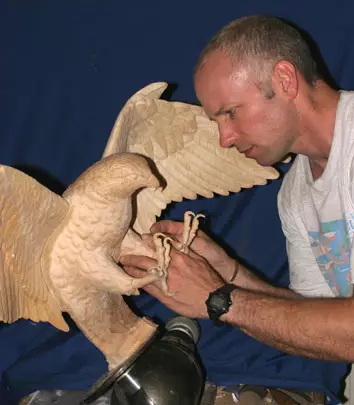

Bill Prickett is an unusual mixture of interests and life experiences. A gifted woodsculptor who is regarded as amongst the most talented in the UK, Bill didn’t start carving full time till his 30s. Born in 1965 in Kent, UK, Bill was intent on working with animals and at 17 he started work as a dolphin trainer at Windsor Safari Park.
Bill’s originals are carved in wood. For his more detailed sculptures he generally uses lime wood. Lime is hard enough to take detail well, and doesn’t have too obvious a grain. This means that fine details such as feathers are not overshadowed by the figuring of the wood.
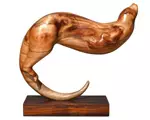

Laminated originals.
Bronzes
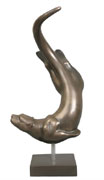

The piece, now coated in a ceramic shell, is fired in a kiln. This bakes the shell and melts the wax, which runs out of the mould, leaving a cavity in its place. (Thus the term, "LOST WAX.") The ceramic shell is removed from the kiln and molten bronze is poured into the mould. This is left to cool and the ceramic shell is cut away. The cooled bronze is a replica of the wax cast, including the sprues and funnel. These are cut away by an Artisan. Then by grinding, chasing, sanding and polishing, all areas are blended back to make the bronze look exactly like the artist’s original sculpture. The bronze is now treated with chemicals and heat to give it the chosen patination. The patina is sealed under a wax coating and becomes a permanent part of the sculpture.
Bronze resins are made on site at Bills workshop. He makes the moulds, and produces the bronze resins himself. This means he can control the quality of the final object. They look almost identical to bronzes, but are made of polyester resin, with bronze powder and colour added to the mix. They are sometimes called cold cast bronzes.
A silicon mould is taken from the orginal sculpture, which is coated with a case, usually of fibreglass, for strength. Mould making is an art in its own right, and takes many years to of practice to perfect. For some of the more complicated sculptures, it can take days to make a mould.
A resin/bronze mix is poured into the mould and left for 24 hours to cure. The resin casts are then pulled from the mould. The cast is then fettled (cleaned and any air-release holes or seams made good) wire-wooled, to expose the bronze, and waxed. The casts are numbered, as part of a limited edition.
Gallery – CLICK HERE
Bronzes – CLICK HERE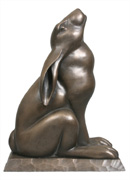

Birds of Prey CLICK HERE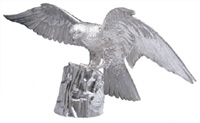

Originals CLICK HERE

Laminated Items CLICK HERE
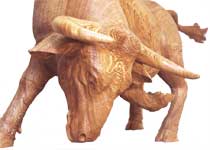

Work in Progress CLICK HERE
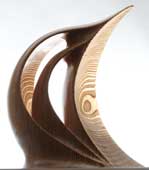

Marine Sculpture CLICK HERE
Exhibitions – CLICK HERE
Email – [email protected]
Website – http://www.billprickett.co.uk/
Teaching – Group Courses and one-to-one Tuition
If you would like any other details please either email: [email protected] phone us on +44 (0) 845 257 0887 (UK – local call rates) or+ (0)1795 892039.
